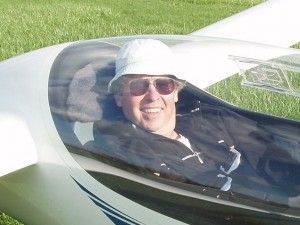I think you all know by now that we did not fly today at Perry. We woke up to low clouds and it got worse later. Weather aside, we had the pilots’ meeting per the schedule and it included a WX brief that confirmed our collective wisdom…. NO flying today. One simple guide for us lesser mortals… if the weather man does not get his glider out of the box, don’t bother getting yours out, unless you need to do some work on it. I had a couple of things to do to mine, so BZ saw a bit of daylight, not much sunshine mind you.
Even though we were not going to fly, we still had two safety presentations. Also, Henry Retting told us about what it is like to retrieve a land out during a thunderstorm, but you will have to read Frank Paynter’s blog to find out what happened.
Oh! And the CD presented the weather guy with a paddle. Background on this is, you will remember, the weather on Tuesday did NOT turn out as predicted. Ray grumbled something like, “We could have flown a 4 hr task.” The paddle was a good gift, since Scott Fletcher was, in the words of the CD, “already up the creek without one.” All of it was done in good clean fun and Scott took it in good humor.
LEARNING POINT: If you are thin-skinned and don’t have a well-founded sense of humor, stay away from this crowd.
The fact that there was no flying did not mean there was nothing to learn from the day. There are always things to do and people to talk with. I had conversations with Francios Pin, John Lubon, Ray Galloway, Fernando Silva, and Henry Nixon.
From Ray, I learned the importance of teaching American glider pilots to fly Assigned Tasks (AT). The assigned task requires a definite destination, rather than an area 5 to 20 miles in radius. The US flies TAT’s more often than any other task; the world glider competition flies significantly more AT’s. Our teams, he thinks, are at a disadvantage for not practicing them. Two, it forces pilots to deal with less favorable weather rather than just picking a different destination as in a TAT. It helps them learn how to “shift gears” when conditions change.
There are advantages to flying TAT’s too. From my conversations with John Lubon, Francios, Doug Jacobs, Fernando, and Hank I think they all favor the TAT because it allows them to fly energy lines. Speed is important and even most important if you don’t have to go to a particular destination. In scoring a TAT, distance and speed are the two parameters used. Another reason for using TAT is that it allows pilots of differing skill levels to fly in the same task. Faster pilots can go deep into the circle and pilots possessing less well-developed skills can still make it around the task, reducing the number of land outs.
Flying energy lines is a term use a lot by these pilots because it allows them to fly the fast routes consuming the least amount of potential energy. They all seem to know what it is and when I listen to them, I think I understand it. However when I try to fly energy lines, they are a bit more difficult to follow. I have mentioned in past blogs that flying straight lines is important and it is true that it is the shortest distance to the destination. BUT it is not always the fastest. Fastest wins shortest may not. Fernando, thinks the American team needs to use faster cruise speeds, since it is a main determinate in measuring the task speed. SeeYou gives a pretty good measure of that speed, in the statistics page. Circling time hurts that speed more than course deviation. So I can deviate and fly 5% farther, and be faster than circling 5% longer on the shorter course. Two mph over a 3 hr task can mean the difference between winning the day and not.
The main driver for following energy lines is to fly long distances without turning in a circle. Long distance means flying 20 to 50 miles. Following lines of energy allowed Francios can fly his task 10 mph faster than the rest of the field. I look at it this way, if I can fly one mile in zero sink, that is worth more than a 200-feet/min thermal. If I can gain 200 feet, it is more still. In my last flight, I had four stretches, in excess of 10 miles with L/D greater than 50:1, flown at speeds faster than 88 mph. These guys do the same thing; they just do it better, longer, and more often.
Francios, Hank, Doug like clouds to lead them.
While I had looked for clouds to circle in a thermal; they seem to look for clouds that will move them forward without circling. I asked Francios about his really fast run on the 2nd contest day and he said, “Give me clouds and I am a happy camper.” In my conversation with Fernando, he added that “haze domes” connect the dots between visible energy lines, marked by clouds.
I am listening to these pilots who are trying to describe what they can see in their mind’s eye as well as the visual cues that guide their decisions to move right or left to stay with the lines of energy that they believe are in front of them. Hank said, “It is not just up and down, (with the nose, driving to the next thermal) but left and right” (looking for the next bit of lift to keep moving forward).
I think I will look at clouds with a different eye and see if I can move on lines of energy and not circle on thermals.
BZ








2 comments for “April 18 at Perry – A Nugget’s View of the Region 5 North”